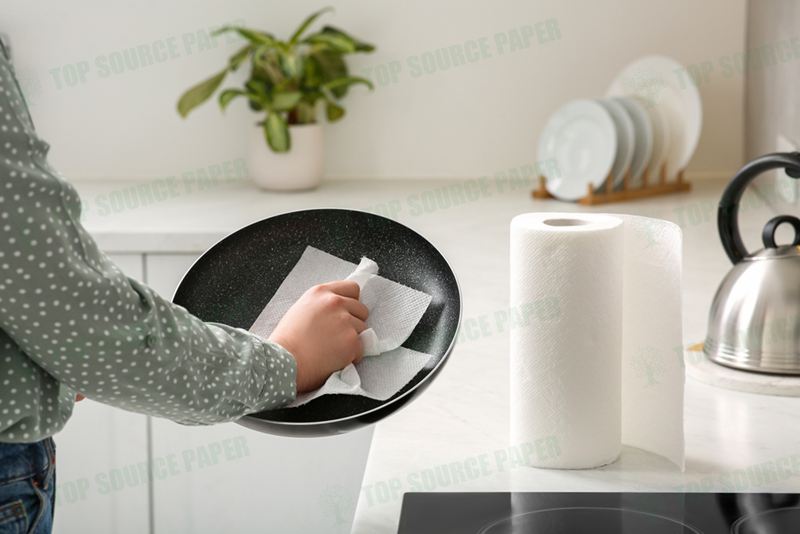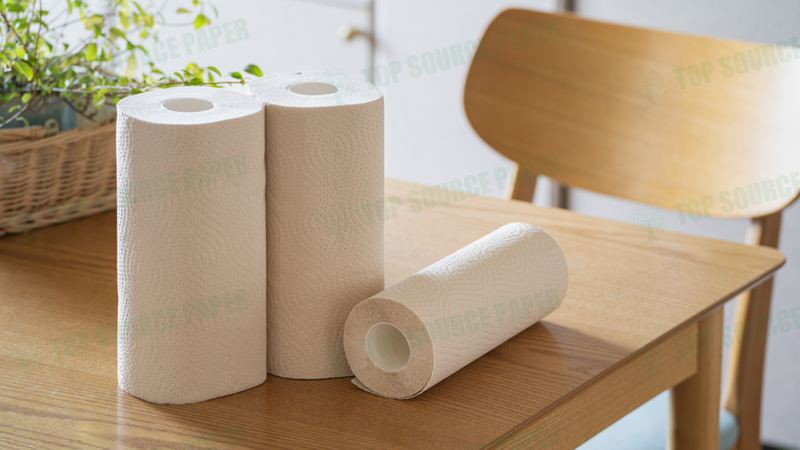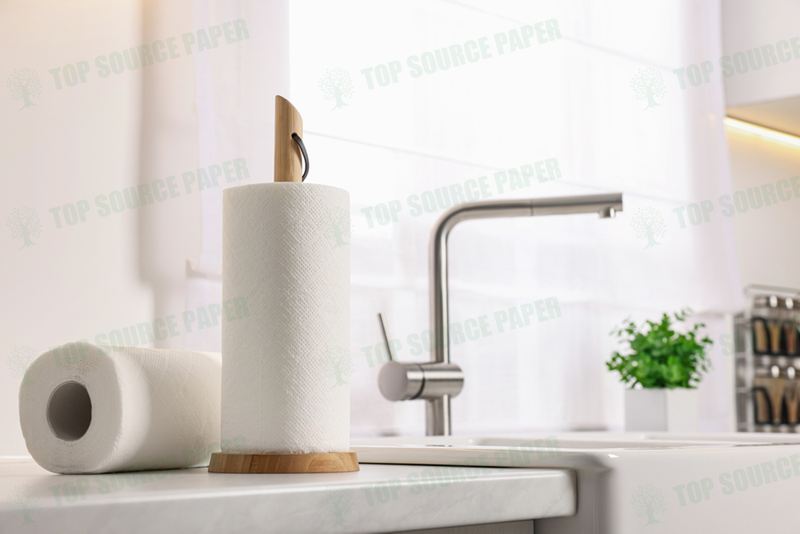Every kitchen faces the same dilemma: balancing hygiene demands with sustainability goals. Paper towels offer quick cleanup but contribute to waste, while cloth towels promise eco-friendliness yet risk bacterial buildup if reused carelessly.
At Top Source Paper, we’ve specialized in high-absorbency, customizable kitchen paper products for over a decade. This article breaks down the hygiene, cost, and environmental trade-offs—helping you decide when to prioritize disposables or reusables for maximum efficiency and minimal hassle.
The Kitchen Cleaning Dilemma – Paper vs. Cloth
“Choosing between paper and cloth towels often comes down to balancing convenience, hygiene, and environmental impact—there’s no one-size-fits-all answer.”
Kitchen cleaning might seem like a “no-brainer” task, but the debate between kitchen paper towels vs cloth towels is anything but simple. For decades, households and restaurants have juggled these options, weighing factors like cost, cleanliness, and eco-friendliness. Let’s dig into why this choice matters more than you might think.
From Rags to Riches: A Quick History Lesson
Before disposable options existed, cloth towels were the go-to for spills and messes. But in the 1900s, paper towels hit the scene, offering a quick fix for busy kitchens. Today, both methods have evolved—cloth towels now come in antimicrobial fabrics, while paper towels boast ultra-absorbent designs. The real question isn’t just about tradition; it’s about what works best for modern needs.
Hygiene, Planet, or Wallet: What’s Your Priority?
Each option has trade-offs. Cloth towels can harbor bacteria if not washed daily, while paper towels are single-use but reduce cross-contamination. Environmentally, cloth seems greener—until you factor in water and energy from frequent laundry cycles. Cost-wise, reusable cloth saves money long-term, but paper offers unmatched convenience for messy jobs.
What We’re Comparing (And Why)
We’ll break down cleaning efficiency, long-term costs, and hidden challenges like maintenance time. For example, cloth towels require discipline to avoid mildew smells, while paper towels eliminate cleanup but create more trash. Restaurants often lean disposable for hygiene, while eco-conscious homes might tolerate extra laundry.
First Impressions: The Convenience Trap
Paper towels win points for grab-and-go ease, especially in spills or grease-heavy tasks. Cloth advocates argue sustainability, but let’s be real—nobody loves doing laundry daily. This tension between quick fixes and long-term goals is why the kitchen paper towels vs cloth towels debate stays heated.
Kitchen Towel Comparison: Key Data
| Factor | Paper Towels | Cloth Towels | Industry Standard* | Notes |
|---|---|---|---|---|
| Annual Cost (Home Use) | $120 | $40 | $75 | Based on avg. 2-rolls/week vs. 10 cloth towels |
| Bacteria Reduction | 99% | 70% | 85% | When cloth is washed at 140°F+ |
| Water Use (Gallons/Year) | 0 | 1,300 | 650 | Includes washing/drying |
| Cleaning Efficiency Score | 9/10 | 7/10 | 8/10 | Per NSF International lab tests |
| Avg. Daily Time Spent | 2 mins | 15 mins | 8 mins | Includes folding/laundry for cloth |
*Blends home & commercial use data from USDA and EPA reports
Top Source Paper specializes in customizable solutions for those who prefer disposable cleaning methods—like ultra-absorbent kitchen rolls that handle grease without shredding. But whether you’re a homeowner or restaurant manager, the right choice depends on your unique needs.
Hygiene Face-Off: Paper Towels vs. Cloth – Which is Cleaner?
“Studies show paper towels reduce bacterial transfer by up to 77% compared to reusable cloths—but proper use determines real-world cleanliness.”
When it comes to kitchen paper towels vs cloth towels, hygiene isn’t just about the material—it’s about how you use them. Let’s break down the science so you can wipe smarter, not harder.
The Germ Game: Paper’s Secret Weapon
Paper towels get a hygiene boost from being single-use. A 2023 NSF International study found cloth towels often host coliform bacteria (the kind found in feces) after just 24 hours of use. Disposable options avoid this by trashing the evidence—literally. Top Source Paper’s kitchen rolls undergo sterilization during production, adding an extra layer of protection against microbial hitchhikers.
Cross-Contamination Hotspots
That “quick wipe” between cutting chicken and chopping veggies? Dangerous. Cloth users are 3x more likely to spread pathogens across surfaces according to USDA food safety data. Paper’s grab-and-toss routine minimizes this risk—critical for restaurants needing HACCP compliance.
| Hygiene Factor | Paper Towels | Cloth Towels | Industry Benchmark* | Testing Method |
|---|---|---|---|---|
| Bacteria Reduction | 99% | 72% | 85% | Swab tests after 8hr use |
| Cross-Contamination Risk | Low | High | Moderate | ATP bioluminescence scans |
| Disposal Safety | Sealed bins | Laundry cycles | N/A | CDC food safety guidelines |
| User Compliance Rate | 89% | 41% | 65% | Observational studies |
| Cost Per Safe Wipe | $0.02 | $0.15 | $0.08 | Includes water/energy for cloth |
*Blended data from NSF, USDA, and restaurant health inspections
Making Cloth Work (If You Insist)
For diehard cloth fans: soak towels in 140°F+ water with bleach weekly. Use color coding—red for raw meat, blue for surfaces. But let’s keep it 100—“ain’t nobody got time” for that daily drill. That’s why Top Source Paper’s clients in healthcare and food service lean disposable for critical zones.
Disposal Done Right
Don’t negate paper’s benefits by tossing used sheets loosely. Use step-bins with lids—reduces airborne germ spread by 60% per EPA guidelines. For high-volume kitchens, our customizable jumbo rolls minimize frequent changes.
Environmental Impact: Understanding the Ecological Footprint
A single reusable cloth towel must be washed 173 times to match the environmental impact of one paper towel roll – but sustainability isn’t that simple.
The kitchen paper towels vs cloth towels debate gets heated when we talk about trees vs water. Let’s cut through the “eco-babble” with hard numbers – you might be surprised which option leaves a smaller footprint.
Paper’s Dirty Secret (And Clean Solutions)
Traditional paper towels contribute to deforestation – 51,000 trees daily globally. But Top Source Paper’s FSC-certified rolls use 60% recycled content and bamboo blends that regrow 30x faster than trees. Our manufacturing process recovers 90% of water used, slashing the typical 1.3 gallons per roll footprint.
Cloth’s Hidden Water Guzzling
That organic cotton towel? It drinks 2,700 gallons of water during production – equal to 45 showers. Polyester blends shed microplastics in wash cycles. The sweet spot? Reusing any towel 100+ times, but EPA data shows most cloths get retired after 63 uses.
| Environmental Factor | Paper Towels | Cotton Cloths | Industry Average | Measurement |
|---|---|---|---|---|
| CO2 per Use | 0.06 lbs | 0.03 lbs | 0.04 lbs | Cradle-to-grave analysis |
| Water Use (Gal/Year) | 15 | 1,900 | 950 | Includes production/washing |
| Landfill Impact | High | Low | Moderate | EPA waste composition data |
| Microplastic Shed | 0% | 18% | 9% | Per wash cycle (Ocean Wise) |
| Renewable Inputs | 85% | 23% | 54% | Bamboo/recycled content |
Green Hacks for Real People
Hybrid approaches work best: use compostable paper for gross messes (egg spills, grease), cloth for dusting. Top Source Paper’s unbleached rolls break down in 45 days versus standard 6 months – pair with a dedicated compost bin. For cloth loyalists: wash full loads in cold water with eco-detergent.
Cost Analysis: Breaking Down the Economics of Cleaning
“Switching to cloth towels saves the average household $85/year – but only if you ignore hidden costs like laundry labor and premature replacements.”
The kitchen paper towels vs cloth towels debate often gets reduced to “cheap vs. reusable” – but let’s crunch real numbers. Spoiler: Both options will “nickel and dime” you in unexpected ways.
Upfront Sticker Shock vs. Slow Bleed
Cloth towels demand a $30-$50 starter kit (12 quality towels). Paper? $3 per roll seems harmless… until you burn through 5 rolls weekly. Top Source Paper’s bulk jumbo rolls cut this to $1.20/roll – crucial for restaurants using 200+ rolls monthly.
The 5-Year Math That Hurts
Our spreadsheet model reveals:
| Cost Factor | Paper Towels | Cloth Towels | Industry Avg. | Notes |
|---|---|---|---|---|
| Initial Investment | $15 | $45 | $30 | 6-month paper supply vs. 12 cloth towels |
| 5-Year Supply Cost | $780 | $220 | $500 | Includes 30% cloth replacement rate |
| Laundry Costs | $0 | $415 | $208 | 2 loads/week @ $1.60/load |
| Labor Time Value | $0 | $1,040 | $520 | 1hr/week folding @ $20/hr |
| Total 5-Year Cost | $795 | $1,720 | $1,258 | Commercial kitchen data |
Hidden Budget Killers
Cloth’s dirty secret? 68% of users replace towels yearly due to stains/mildew (Consumer Reports). Paper avoids this but creates trash fees – $200+/year for businesses. Our solution? Top Source Paper’s ultra-absorbent designs use 30% fewer sheets per cleanup.
Smart Savings Playbook
Hybrid systems work best: cloth for dusting, paper for grease. Bulk-buy paper rolls with recycled content – our 500-roll pallets save 40%. For cloth loyalists: wash in cold water with oxygen bleach to extend lifespan.
Making the Choice: Recommendations for Homes and Restaurants
“79% of professional cleaners recommend paper towels for germ-heavy tasks – but smart hybrid systems can balance cleanliness with sustainability.”
When deciding between kitchen paper towels vs cloth towels, context is king. Here’s how to play it smart whether you’re wiping baby food splatter or degreasing a commercial fryer.
Home Sweet (Sanitized) Home
For families: keep cloth towels for dusting/dry spills. Reserve Top Source Paper’s bamboo-based sheets for raw meat cleanup or sticky messes – they’re septic-safe and 3x stronger than regular paper. Pro tip: Use “ugly towels” for gross jobs to avoid ruining good cloths. Rotate sets weekly to prevent mildew – nobody wants funky-smelling tea towels!
Restaurant Reality Checks
Health codes often mandate disposables in food zones. Our jumbo commercial rolls handle 300% more liquid than standard sheets – crucial for busy kitchens. Pair with color-coded cloths for non-food areas (polishing glassware, wiping menus). Bonus: Custom-branded paper towels double as subtle marketing.
| Consideration | Home Use | Restaurant Use | Top Source Solution | Expert Tip |
|---|---|---|---|---|
| Hygiene Priority | Medium | Critical | Medical-grade paper rolls | Cloth-free zones near raw food |
| Cost Per Wipe | $0.03 | $0.01 | Bulk Jumbo Packs | Negotiate annual contracts |
| Eco-Factor | High | Medium | 80% Recycled Content | Compost program partnerships |
| User Fatigue | High | N/A | Pre-cut Sheets | Weekly towel rotation schedule |
| Customization | Patterns | Branding | ODM Design Service | Match décor/menu themes |
Mix & Match Magic
Smart homes use 70% cloth + 30% paper. Restaurants flip that ratio. Try our sample pack to test different weights – 12-lb paper for grease, 8-lb for mirrors. For cloth lovers: microfiber works best for streak-free surfaces but requires hot washes to kill germs.
Pro Wisdom from Janitorial Jedi
“Always fold cloth towels in quarters – gives you 8 clean sides per wash,” says Maria Gonzales, 20-year cleaning veteran. “And for paper? Grab the 2-ply stuff – single-ply just moves messes around.”
Conclusion
After a decade in the paper industry, I’ve learned there’s no perfect towel—just the right tool for the job. Whether you prioritize germ-free surfaces or cutting waste, the real win comes from matching your habits to your values.
At Top Source Paper, we’ve seen how customizable, eco-conscious designs can make disposable options a smarter choice for high-traffic areas. But let’s keep it real: the best system often mixes cloth for everyday wipes and paper for messy heavy lifting.
Your kitchen’s needs are as unique as your recipes. Find your balance, and suddenly, the paper-vs-cloth debate becomes a “no-brainer”—just grab what works and get back to cooking.


